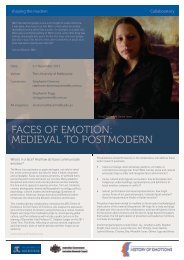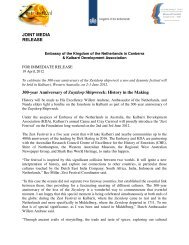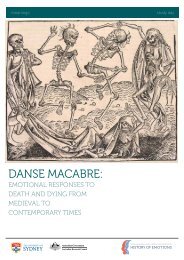Download our K-12 education pack - ARC Centre of Excellence for ...
Download our K-12 education pack - ARC Centre of Excellence for ...
Download our K-12 education pack - ARC Centre of Excellence for ...
Create successful ePaper yourself
Turn your PDF publications into a flip-book with our unique Google optimized e-Paper software.
Supporting Res<strong>our</strong>ces stories <strong>for</strong> teachers & students 2013<br />
Dutch Lives in the World<br />
stories by winthrop pr<strong>of</strong>essor susan broomhall<br />
Sugar, Chocolate,<br />
Marmalade and Fine China<br />
William <strong>of</strong> Orange and his sons might have been famous military<br />
leaders but his female <strong>of</strong>fspring were also contributing to the<br />
family’s hold on power in more subtle ways during the Golden<br />
Age. William’s son Frederick Henry and his wife Amalia created a<br />
new sort <strong>of</strong> power, one that was funded by a huge haul <strong>of</strong> gold<br />
from captured Spanish ships and imports from Dutch global<br />
trade, which directly boosted the Orange-Nassau c<strong>of</strong>fers.<br />
Frederick Henry and Amalia set the trends on luxury, and it was<br />
those things to which they had access through exclusive Dutch<br />
trade thanks to the establishment <strong>of</strong> the trading companies to<br />
the east in 1602 and and west in 1621: exotic, luxury goods such<br />
as Chinese porcelain, spices traded at Batavia and Malacca,<br />
sugar from South America, fur from North America, and gold<br />
and ivory from Africa. The Orange-Nassau family were<br />
trendsetters in showing <strong>of</strong>f luxury goods in The Netherlands and<br />
to Germany and Britain where children <strong>of</strong> the House <strong>of</strong> Orange-<br />
Nassau were married <strong>of</strong>f. They took their name with them,<br />
creating new palaces and castles named after their family: such<br />
as Oranjewoud, Oranienstein, Oranienburg, and Oranienbaum,<br />
even painting the buildings orange, and planting orange trees in<br />
their gardens. Orange princesses were <strong>of</strong>ten painted holding<br />
orange blossom in their hands.<br />
The Dutch held a monopoly on the importation <strong>of</strong> Chinese<br />
porcelain into Europe during the seventeenth century. Amalia<br />
held many pieces given to her as gifts by the VOC and European<br />
diplomats because it was widely known that the path to Frederick<br />
Hendrick’s ear was through Amalia. Porcelain not only reflected<br />
contact with the exotic east but these particular vases reflected<br />
the craze <strong>for</strong> the equally exotic tulip which had taken the Dutch<br />
Republic by storm. Amalia had special rooms designed as<br />
porcelain display cabinets. After her death, Amalia’s porcelain<br />
was divided between her f<strong>our</strong> daughters Henriette Louise,<br />
Henriette Catharina, Albertine Agnes and Maria. All the<br />
daughters, three <strong>of</strong> whom had been married <strong>of</strong>f into German<br />
lands, furnished their palaces in distinct Dutch style, including<br />
the display <strong>of</strong> the porcelain collections in separate porcelain<br />
cabinets, in subterranean kitchens, or in garden grottos.<br />
These kitchens were located on the side <strong>of</strong> the princesses’<br />
gardens and displayed the richness <strong>of</strong> Dutch-imported Chinese<br />
and Japanese porcelain. It could also be used <strong>for</strong> the display <strong>of</strong><br />
flowers, especially exotics established in Europe from Dutch<br />
colonial enterprise. It seems that the kitchens’ owners like<br />
Henriette Catharina used these spaces to prepare jam and some<br />
candied fruits (orange peel and sugar) which were <strong>of</strong>fered at the<br />
end <strong>of</strong> entertainments and balls, and given as gifts. Delft tiles<br />
decorated these summer houses from floor to ceiling. Delft<br />
blue-and-white tiles, especially those with Biblical motifs, were<br />
popular in rich Dutch households, but, because they were<br />
expensive, only a few were ever used in upper-class Dutch<br />
displays as features. In contrast, in Henriette Catharina’s<br />
Oranienbaum palace several thousand <strong>of</strong> these precious Delft<br />
tiles were displayed.<br />
IMAGE/ Theepot, Porzellanmanufaktur Nymphenburg, ca. 1760 - ca. 1770.<br />
© Rijksmuseum<br />
family’s colonial power and superior access to consumer goods<br />
which the emerging VOC and Dutch colonial power gave them.<br />
The Dutch were the first to import tea into Europe and to develop<br />
tea drinking into a social habit <strong>of</strong> the upper class. Drinking tea<br />
was restricted to a more intimate circle, so to be invited was a<br />
real hon<strong>our</strong>. The hostess herself would prepare and p<strong>our</strong> the tea<br />
to her guests. Sugar and candied fruit were served as well. We<br />
have a painting depicting Henriette Catharina and her daughters<br />
at such a tea session. The inventories <strong>of</strong> the Nassau family list<br />
many porcelain containers and tea sets. Tea sets were ordered<br />
by the Orange princesses living in Germany as gifts.<br />
So Nassau women were using porcelain to advance the<br />
reputation <strong>of</strong> their family, just as their fathers and brothers were<br />
fighting <strong>for</strong> it in war. They showcased the economic strength <strong>of</strong><br />
their homeland and family, by using the new luxurious and rare<br />
products <strong>of</strong> the Dutch-controlled colonial world - tulips, tea,<br />
sugar, c<strong>of</strong>fee, plants – in secluded, kitchen and garden spaces<br />
associated with women and in activities considered suitable<br />
occupation <strong>of</strong> a aristocratic lady’s time. The glory <strong>of</strong> the Orange<br />
family spread far and wide – members <strong>of</strong> the dynasty eventually<br />
becoming Kings <strong>of</strong> Prussia in Germany, and <strong>of</strong> England, Wales<br />
and Scotland, as well as <strong>of</strong> The Netherlands today.<br />
Porcelain was also important as part <strong>of</strong> Orange- Nassau<br />
ceremonial social life. For example, porcelain tea and chocolate<br />
sets figure prominently in the possessions <strong>of</strong> these women. Tea,<br />
sugar and chocolate were <strong>of</strong> c<strong>our</strong>se further evidence <strong>of</strong> their<br />
64 FAR FROM HOME: ADVENTURES, TREKS, EXILES & MIGRATION












